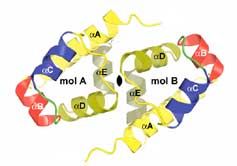
Handy Links
SLAC News Center
SLAC Today
- Subscribe
- Archives: Feb 2006-May 20, 2011
- Archives: May 23, 2011 and later
- Submit Feedback or Story Ideas
- About SLAC Today
SLAC News
Lab News
- Interactions
- Lightsources.org
- ILC NewsLine
- Int'l Science Grid This Week
- Fermilab Today
- Berkeley Lab News
- @brookhaven TODAY
- DOE Pulse
- CERN Courier
- DESY inForm
- US / LHC
SLAC Links
- Emergency
- Safety
- Policy Repository
- Site Entry Form

- Site Maps
- M & O Review
- Computing Status & Calendar
- SLAC Colloquium
- SLACspeak
- SLACspace
- SLAC Logo
- Café Menu
- Flea Market
- Web E-mail
- Marguerite Shuttle
- Discount Commuter Passes
-
Award Reporting Form
- SPIRES
- SciDoc
- Activity Groups
- Library
Stanford
Around the Bay
Protecting Against DNA Invasion
 X-ray studies conducted at SSRL have shed light on a sword-and-shield type of defense used by
bacteria to protect themselves from viral attacks. This new knowledge could prove significant
to medical research on human cancers caused by a similar defense mechanism gone awry.
X-ray studies conducted at SSRL have shed light on a sword-and-shield type of defense used by
bacteria to protect themselves from viral attacks. This new knowledge could prove significant
to medical research on human cancers caused by a similar defense mechanism gone awry.
Researchers from the City of Hope cancer research and treatment center in Duarte, California, determined the crystal structure of the protein that controls this defense system in bacteria called Bacillus caldolyticus. Unless stopped, viral DNA slips into bacterial DNA, where it gets copied many times over, and then destroys its host.
To protect bacterial cells, the control protein ensures the proper ratio between two enzymes, the "swords" and the "shields." The sword enzyme slashes invading viral DNA into useless pieces. The shield enzyme adds a protective layer to bacterial DNA, so the sword won’t cut its master. Too few shields lead to bacterial cell death, and too many shields protect the viral DNA as well.
X-rays of the control protein revealed small structures that make it likely that the protein adjusts the levels of the defense enzymes by sliding along the bacterial DNA, bending and changing its shape to turn on or off the defense genes.
The defense system is fine-tuned. The swords can cut only at particular sections of DNA. The shields therefore add a methyl group at these cutting points on the bacterial DNA so it can't be chopped. Uncovering the control protein's structure is a first step toward understanding the human cancers caused by the abnormal addition of methyl groups that silence protective genes.
—Heather Rock Woods
SLAC Today, June 21, 2006
Image: The structure of the control protein named C.BclI was determined at SSRL. (Click on image for larger version.)